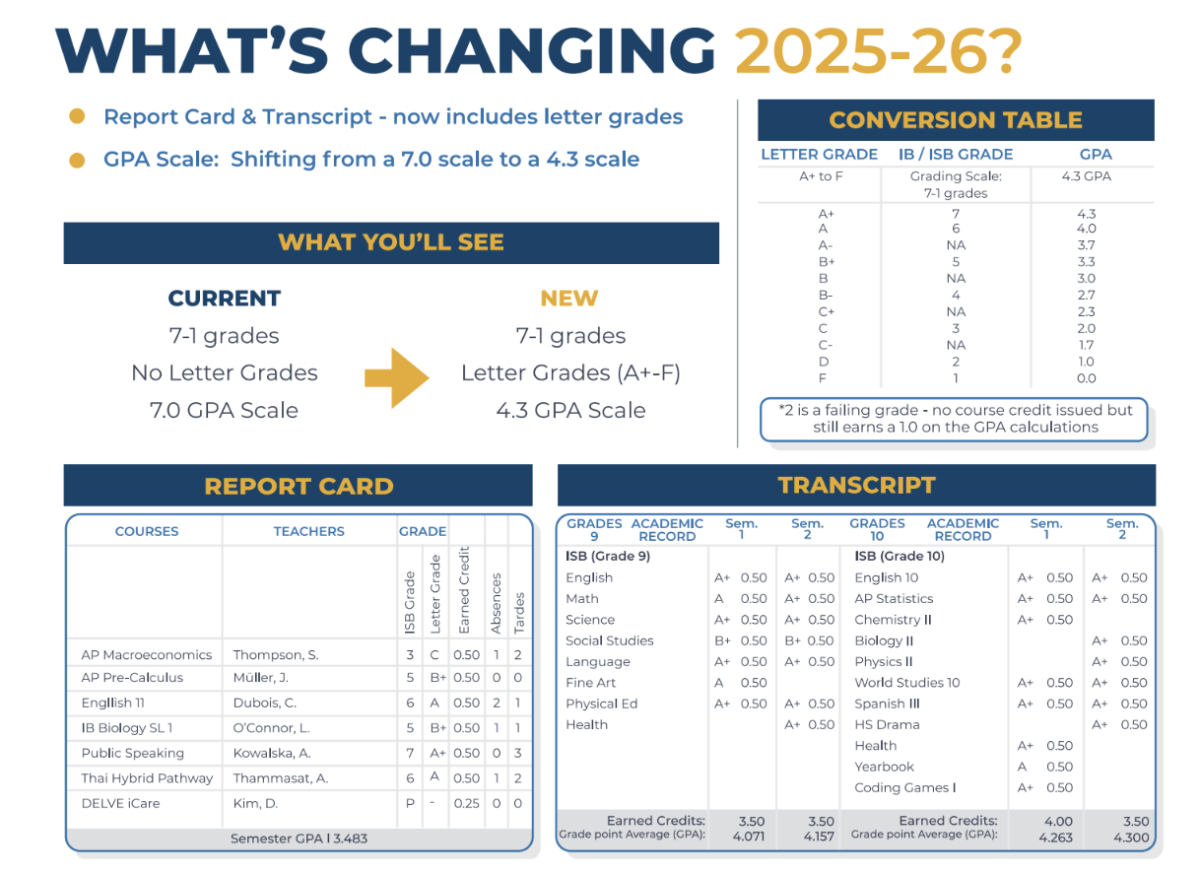ISB administration announced last week that it will transition to using letter grades (A+ to F) on student report cards and transcripts in the 25-26 school year. Additionally, ISB will no longer measure GPAs on a 7.0 scale but instead on a 4.3 scale to align more closely with North American reporting practices.
Curt Nichols, ISB’s director of university counseling, says the change was precipitated by the introduction of more AP classes, which use a 1-5 grade scale, and the need to create a universal grading system. “When we have multiple curricula, it wouldn’t make sense to have a grading scale that is exclusive to the IB, so we’re going neutral,” he says. “That’s the thought process.”
Teachers will continue existing assessment practices to determine a 1-7 number grade, which will then be converted to a letter grade using the new grade letter scale. “This move requires minimal change for teachers and ensures familiarity with existing students and parents whilst slowly introducing the letter grades,” according to the slide presentation Principal Justin Alexander shared with parents.
 What isn’t lost on students is that the new system and its accompanying GPA calculations will boost everyone’s GPA, though students who are less elite stand to gain the most, as a 3 under the new system now becomes a C (a 2.0 on a 4.0 scale), whereas a more standard GPA conversion such as the one used by the University of California would regard a 3 as a D (or a 1.0 on a 4.0 scale).
What isn’t lost on students is that the new system and its accompanying GPA calculations will boost everyone’s GPA, though students who are less elite stand to gain the most, as a 3 under the new system now becomes a C (a 2.0 on a 4.0 scale), whereas a more standard GPA conversion such as the one used by the University of California would regard a 3 as a D (or a 1.0 on a 4.0 scale).
For instance, a student who participated in three athletics seasons during the year received the grades in the table to the left. To this student, athletics are more of a priority than academics. According to the conversion scale used by University of California, which is somewhat typical, the student’s average GPA under the current system is 2.6. Their GPA under the new grading system is 3.1, a half-point increase. While more elite students will also gain, the new grading system will benefit less elite students more, as they have more room to move up.
“I feel like in the short term it might help,” says sophomore Nan Luangon, “but I feel like in the long term because of like — they did say that in most schools a 4 would be a C but then we have it as a B- — so I feel like in the long term we might have a grade inflation, which is not good.”
In fact, U.S. high schools have seen significant grade inflation over the last decade, with average GPAs rising markedly. Grades and high school GPA used to be the most reliable predictor for college success, but with more students achieving high grades without fully mastering content, it is becoming harder for colleges in the U.S. to assess applicants. For example, Edison High School in Fresno, Calif., had 115 valedictorians in 2022.
A study by Harvard researcher Raj Chetty analyzed data from various universities: Duke, MIT, Stanford, and UChicago. Chetty’s research concluded that there was little relationship between high school grade point average and success in college. Grades are also becoming less meaningful due to grade inflation as A averages are easier to achieve, therefore making it harder for colleges to distinguish between what truly constitutes A-level work.
Nichols concedes that the new grade reporting will benefit students but says that is a more fair way to represent our students as they are compared to other applicants. “I would say, if there was any benefit to any student, like a real benefit, it’s probably students who have 4s, you know, where that may have been a C and now it’s more of a B-,” he says. “If they get slightly better results than they would have before, great.”
For students applying to non-U.S. universities, the new system will have no real effect. “Many of the universities our students apply to outside of the U.S. exclusively use AP/IB predicted and actual scores for admission without ever seeing the ISB transcript, and those will continue to be reported on the AP (5-1) and IB (7-1) scales,” according to the slideshow ISB administration shared with parents.

This is not the first time ISB has used letter grades. According to the slideshow shared with parents, prior to 2017, ISB used a letter grade scale (A+ to F) to report results/achievement to students, parents and universities via report cards and transcripts. During that time students taking an IB class had their IB grade (1-7) converted into a letter grade by using a conversion table. From 2012 to 2016, ISB saw a steady increase in the number of students taking the full IB Diploma in grades 11 and 12. So in 2017, ISB shifted to a 1-7 grading scale.
Freshman Jaden Perry says he applauds the change. “I think it’s going to be good, especially for me because I’m trying to go to college somewhere in the U.S.,” he says.







